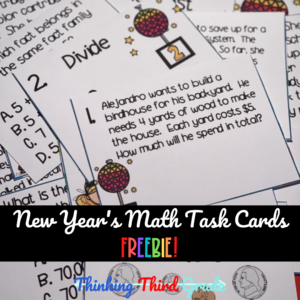On Teaching Math
I teach in the state of Texas and we have our own unique set of standards and our own wonderful STAAR test. If you are a teacher who deals with annual state or national assessments, you know the word, “wonderful” is used in the most sarcastic sense in that last sentence! However, it is the hand I have been dealt as a Texas teacher, and what are teachers best at if not adaptability, even in the yuckiest of teacherly circumstances.
While my current assignment is teaching English Language Arts and Social Studies, my true teaching love is math. I’m not sure why this is. I’m an avid reader and obsessed with books. When I was in school, I struggled like you wouldn’t believe with math. There is just something about teaching math that makes it clear cut and less of struggle than teaching reading and writing and it’s just plain fun to teach!
That being said, let’s get into some of the ways that I found best helped my students overcome challenges in math.
Practice is Important
We all know that old adage that says, “practice makes perfect.” And seasoned teachers know that there is so much truth to this expression, especially when it comes to math. Students need daily practice in math operations and problem solving in order to master it.
For many students, problem solving in especially challenging, as word problems are not only math problems, but also reading problems. This is where math and reading work hand in hand. Practicing math and reading daily helps students to become higher achievers in both areas.
So… How Should They Practice?
The simple answer is, “in every way possible!” In my classroom, we employed numerous tactics. We did a “Problem of the Day” and daily spiral reviews. We were involved in school wide daily fact practice, as well as weekly competitions in our classroom. Whole group instruction lead to small group instruction, during which time students worked on independent practice of that day’s taught skill, in addition to math centers where students not only practiced the skill of day, but spiraled back over previously taught concepts.
Morning Spiral Review
This is our “bell-ringer” each morning. As students come in, put supplies away, eat breakfast, and get ready to listen to announcements, they work on spiral review, which covers all the things we’ve learned in the school year (or that they have learned in previous years, if it’s early on). They do this independently and may quietly ask a neighbor for help. We spend time at the beginning of the year discussing what “help” looks like vs. giving answers. Most days, I try to make the time to review students answers before moving on to fact practice.
Fact Practice
Timed fact practice works really well to help students build fact fluency. We usually start off with 3 minutes and practice daily first thing during our math block. On Fridays we test.
Every year I’ve taught math, my students have competed in THE FACT OFF (more information and a resource coming later this year!). My students are obsessed! We practice out loud Monday-Thursday and the big event happens weekly on Fridays. The winning student gets some sort of prize such as extra library time or free computer time. We keep track of the weekly leaders and have a celebration and an ULTIMATE FACT OFF each year in May.
Problem of the Day
After fact practice time, we move into our Problem of the Day. This is typically done whole group for at least the first 6-9 weeks of school, before I start turning students loose on this one their own. At that point, students complete the Problem of the Day after working on Spiral Review and we briefly review it before getting started with the rest of our math block.
Instruction Time and Independent Practice
My school district uses Origo as our math adoption. Without getting too into that, I am not an Origo fan. At all. I will use it for initial teaching purposes and sometimes practice, but I also find other ways for my students to practice the concepts that are taught each day. Students move on to independent practice after we have had whole group and guided instruction.
Center Time and Early Finishers
I generally use task cards as my center time and for my early finishers, but I have also used a variety of math “centers” and online tools for students to continue their math practice while I work with small groups and individuals. This allows students to practice concepts previously taught, as well as current math skills.
Tools For Practice
I’ve developed an entire line of Problem of the Day and Math Spiral Review which can be used for every single day of the school year. Problem of the Day is available in both print and digital versions and Math Spiral Review is available and print (digital versions are coming!). I also employ task cards which review everything my students have learned up to that point. You can find a variety of task cards in my store, as well as math practice for different skills, including practice for all four operations – addition, subtraction, multiplication, and division. I’m currently converting my Holidays and Seasons Task Cards to digital for distance learning and technology integration!
A Freebie!

Speaking of holiday task cards, click HERE to grab a free printable version of math practice task cards for New Year’s and HERE to grab the digital version! If you like these, please check out my other Holidays and Seasons Math Task Cards!
For a free week’s sample of my Problem of the Day line, sign up for my email newsletter using the form to the right!
Thanks for reading today and I’ll see you (virtually) again soon!

Leave a Reply